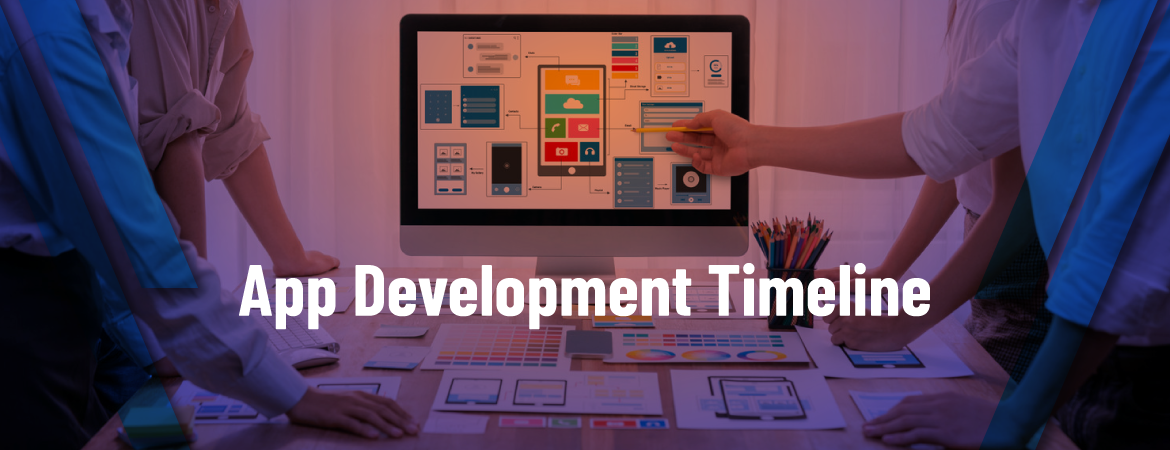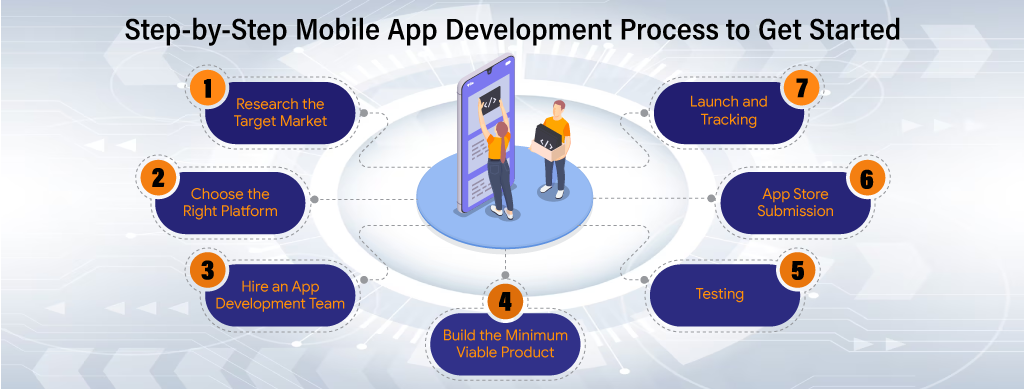
We use cookies to ensure that we give you the best experience on our website.
By using this site, you agree to our use of cookies. Find out more.
Mobile application requires meticulous planning right from ideation to launch and beyond. While costs and timelines may vary based on several project aspects, aiming for an MVP early, prioritizing features, involving quality checks, strategic outsourcing and cross-platform strategies can significantly optimize expenses.

In today's digital world, mobile applications have become an integral part of our daily lives. Whether it's for communication, productivity, gaming or e-commerce - apps have significantly changed the way we live and work. With more than 2.5 million apps available on Google Play and App Store combined, building a successful app in this competitive landscape requires extensive planning, focus on user experience and investment. In this blog, we will explore the typical timeline and cost estimates involved in building a mobile application in 2023 from the perspectives of Mobile Application Development Company. We will look at factors influencing development costs, hidden expenses, step-by-step processes and strategies to optimize budgets. The goal is to provide insight into the end-to-end mobile app development journey so entrepreneurs and businesses can effectively plan their projects for a quality product within set constraints.
The average cost of developing a mobile app can range quite widely depending on aspects like the app idea, features, targeted platform and complexity of the project. However, a basic estimated cost range for a native app is between $50,000 to $250,000. For a mid-range app, expect costs of $100,000 to $500,000. For more advanced, complex apps, costs may exceed $500,000. These estimates cover a full development cycle including initial planning, creating mockups, developing the app, testing, fixing bugs, security implementation and app store publishing. Additional ongoing expenses are needed for maintenance, updates and support over time. Web-based or hybrid apps could cost 10-30% less to develop than the equivalent native apps. Keeping features focused and optimizing for a specific platform helps reduce initial investment.
Here are some of the top factors that impact mobile app development cost:
The complexity of the mobile app is the largest determinant of costs. Apps with highly customizable and customizable features, complex payment integrations, real-time functionalities, intensive use of devices sensors/camera and intricate backend operations will be more expensive to design, code, test and debug. Simple apps featuring basic features like contact lists, schedulers etc can be produced at cheaper prices.
Core necessary features have lower price points than novel or advanced optional functions. Prioritizing key functionalities allows focusing efforts to deliver basic app needs affordably. Additional "nice-to-have" elements can be optimistically priced and scheduled in phases. More features mean greater engineering manhours, more room for bugs and higher expenses.
Games are generally the most costly due to intensive graphics, animation, interactive components and gameplay mechanics. Complex augmented reality apps also require sophisticated engineering. Social media and communications apps have average costs. Utility apps like flashlights or references have minimal prices. Educational and business tools have moderate expenses relative to their functions.
Elaborate app designs involving motion graphics, complex animations, detailed illustrations and attention to minute graphical details costs significantly more to craft. This precision graphical work demands specialized talent and lengthens development schedules. Subtle, clean and intuitive interfaces can be produced more quickly at lower prices.
The platform chosen impacts expenses - while code can sometimes be reused, native development is more expensive than hybrid or web-based. iOS apps typically cost more than Android due to Apple's additional testing, approval procedures and hardware variability compared to Google. Developing for a single OS minimizes multi-platform challenges and lowers overhead.
After launch, 15-35% of the initial budget needs assigning annually for crucial software maintenance including scheduled updates, immediate bug fixes, supporting new devices/OS, and implementing feature/performance enhancements. Without these investments, apps rapidly become outdated and less satisfactory over time.
Leveraging code snippets, templates and modules from previous, similar projects can significantly accelerate new development cycles and lower costs. However, each app still demands customization for its unique purpose. Incremental improvements to consistent codebases also optimize long-term efficiency.
Outsourcing development saves overall costs versus hiring in-house. However, communication and management become critical. Smaller teams are more affordable but could impact timeline. Local developers typically cost less than using offshore outsourcing.
Here are hidden factors that affecting mobile app development cost:
Thorough testing is crucial but can significantly impact budgets if not planned carefully from the beginning. Establishing a QA process early allows finding and fixing bugs during development instead of after launch, reducing expensive post-release patches. Not allocating enough for a rigorous testing program can lead to quality issues, bugs and crashes that harm the user experience and app ratings.
Building a robust backend infrastructure demands costs for procuring and maintaining servers, databases, payment solutions, analytics software and tools like A/B testing platforms. These are necessary to securely host user data and power key app features. While cloud-based services make infrastructure more affordable and scalable, initial setup and configuration fees still apply.
As apps grow in scope and userbase over time, the need rises for dedicated IT resources to manage backend systems, debug servers, provide customer support and handle security and privacy inquiries. These maintenance roles are indispensable but increase personnel expenses.
Budgets must account for app listing fees on platforms, costs of creating marketing assets like videos, screenshots and copy for app pages. International submissions and localization into other languages involve translation and specific testing. Features like in-app purchases also require special integration time.
Rigorous security audits and testing are now essential due to increased sensitivity around user privacy and data protection. Compliance with standards like GDPR also necessitates legal review which requires payment. While important to safeguard users, these measures contribute additional unforeseen security costs.
Developing a mobile app involves a systematic process that ensures a smooth and efficient development journey. By following a step-by-step approach, you can streamline your efforts and create a high-quality app. Here is a comprehensive guide to the mobile app development process:

Thorough market research is imperative to understanding user needs and requirements. Various research methods like surveys, interviews and analytics can be used. Personas help define key demographic groups. Competitor benchmarking provides insights on popular features, UI trends and pain points faced by similar apps. User journey mapping explores how users currently complete tasks and potential friction points. Market data sources help size the potential audience and growth projections. Technology monitoring keeps abreast of evolving platforms and trends. The research outcome forms a solid foundation for the app concept and later product decisions.
The platform choice impacts the technical implementation, costs and reach. Key criteria to evaluate include the target audience's platform preferences based on demographics and region. iOS and Android have different features, APIs, development tools and guidelines to adhere to. Expertise available in-house or with partners also plays a role. Other considerations involve integration needs, distribution across devices and market share projections. Testing build compatibility early avoids expensive reworks. Careful evaluation of these factors helps choose the optimal platform(s).
To execute the app vision, it is important to engage experienced professionals. Multiple agencies or freelancers can be shortlisted based on past work, skills demonstrated and client reviews. Comprehensive quotes factoring project scope, timelines, payment terms help compare options. Developments process, project management approach, technical and design capabilities are evaluated to ensure a good cultural fit. Legal contracts clearly outline deliverables, timelines, Intellectual Property ownership and non-disclosure terms. This step lays the ground for effective collaboration.
The MVP focuses development initially on the core value proposition with bare minimum features. Considered iterations of wireframes and prototypes gain early feedback. Internal alpha testing uncovers major bugs before external release. Core user flows are implemented to validate the problem-solution fit at a basic level. This quickly puts a working product to demo while balancing development investments at an early stage.
Rigorous testing across various usage scenarios is critical to achieve stability and high quality. Multiple rounds of internal testing help address issues proactively. Formal test cases cover edge conditions around networks, hardware etc. Alpha and beta testing groups provide a close-to-real environment to examine usability. Continuous monitoring of technical metrics provides quick visibility into crashes and errors requiring attention. No stone is left unturned to deliver a robust product.
Submission assets and information are prepared as per the target app store guidelines. Promotional materials help market the app listing page. Configuration settings in terms of taxes, banking etc comply with platform norms. Resolving submission queries on priority avoids delays. Ensuring adherence to quality standards is a prerequisite for app store approval and success.
Raising awareness for the initial release accelerates early adoption. Continuous tracking of key metrics provides first-hand user behavioral data. Actionable insights from monitoring downloads, retention, reviews help optimize the app experience over iterations. The initial launch lays the foundation for long term engagement and monetization through a data-driven approach.
Reducing mobile app development costs is a common concern for many businesses and entrepreneurs. While it's important to maintain quality and functionality, there are several strategies you can implement to optimize costs. Here are some effective ways to reduce your mobile app development costs:
It's important to identify the core functionality of the app during planning. Stick to developing only the most essential features in early iterations to keep costs low. Unnecessary features can always be added later based on user feedback. Prioritizing well reduces the risk of building features no one uses.
Involving QA professionals from the beginning allows bugs to be identified and fixed during development before the app is complete. This prevents expensive reworks and delays later. Thorough testing of each feature as it's built finds issues quickly. Early QA catch errors at lower costs than fixing them post-launch.
Consider future aspects like platform updates, additional user scenarios and monetization strategies upfront. This helps develop architectures that can adapt later through minimal effort. Making provisions now by adding abstraction layers saves money compared to extensive rewrites. It's wiser to plan expansively from the start.
Building in-house allows more control but recruiting talent requires office space and equipment. Outsourcing gives access to specialized skills globally at lower overhead. But lack of oversight may impact quality. Weighing technical needs, budgets and timelines helps decide the optimal approach.
Frameworks like React Native and Flutter allow developing for iOS and Android together, significantly reducing duplicate work and costs. While lacking some platform-specific features, they are faster and cheaper than native coding. For most apps, a cross-platform strategy optimizes the cost-benefit equation.
Developing a high-quality mobile application requires meticulous planning right from ideation to launch and beyond. While costs and timelines may vary based on several project aspects, aiming for an MVP early, prioritizing features, involving quality checks, strategic outsourcing and cross-platform strategies can significantly optimize expenses. Ongoing maintenance is also important for user retention and engagement in the dynamic industry. A Mobile App Development Company with the right expertise can help navigate this process seamlessly to realize the app vision efficiently. With the knowledge gained from this blog, one can confidently estimate project costs and timelines to successfully build an app to solve business problems and capture new opportunities in 2023.
Leave a Comment
Your email address will not be published.